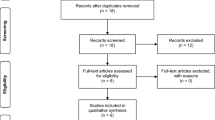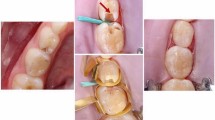Abstract
Introduction
Carious or traumatised teeth with a normal pulp status or with reversible pulpitis need an indirect or direct pulp capping procedure to keep the pulp vital.
Aim
To evaluate the clinical outcome of both interventions for treating vital primary teeth.
Study design
Two reviewers on Pubmed and ISI Web of Science performed a comprehensive literature review of publications from 1966 until December 2017. Among PubMed abstracts, publications were selected according to the following criteria: prospective clinical study, correct indication for the performed treatment, and clear definition of clinical and/or radiographic success criteria. The strict selection criteria limited the amount of randomised controlled trials (RCT) or controlled clinical trials (CT); especially for “indirect pulp therapy”, “direct pulp capping” and the number of RCTs was limited.
Conclusions
Based on a systematic review (20 controlled clinical studies or randomised controlled clinical studies), the following statements can be given: Due to the opportunity of tissue repair, indirect pulp treatment can be an acceptable procedure for reversible pulp inflammation. The use of adhesives for indirect pulp capping in a single-visit procedure after gentle caries removal can be recommended. Successful pulp capping is possible under defined conditions (symptom-free tooth, disinfection of pulp exposures, Class-I cavity) and appropriate sealing of the cavity with an effective dentine seal being a conditio sine qua non. There is maximum evidence for the use of disinfecting solutions prior to pulp capping and Dycal as pulp capping material. Longer follow-up periods, more clinical studies, comparable conditions, and clear definitions of evaluation criteria are needed to confirm the results of endodontic treatment in primary teeth.
Similar content being viewed by others
References
Agamy HA, Bakry NS, Mounir MM, Avery DR. Comparison of mineral trioxide aggregate and formocresol as pulp-capping agents in pulpotomized primary teeth. Pediatr Dent. 2004;26(4):302–9.
Allen KD, Stokes TF. Use of escape and reward in the management of young children during dental treatment. J Appl Behav Anal. 1987;20(4):381–90. https://doi.org/10.1901/jaba.1987.20-381.
Alsheneifi T, Hughes CV. Reasons for dental extractions in children. Pediatr Dent. 2001;23(2):109–12.
Al-Zayer MA, Straffon LH, Feigal RJ, Welch KB. Indirect pulp treatment of primary posterior teeth: a retrospective study. Pediatr Dent. 2003;25(1):29–36.
American Academy of Paediatric Dentistry. Guideline on pulp therapy for primary and immature permanent teeth. Clinical Practice Guideline 2014; reference manual v 37, no 6. 2014. http://www.aapd.org/media/Policies_Guidelines/G_Pulp.pdfPediatr. Accessed 26 Feb 2018.
Aminabadi NA, Farahani RM, Oskouei SG. Formocresol versus calcium hydroxide direct pulp capping of human primary molars: two year follow-up. J Clin Pediatr Dent. 2010;34(4):317–21.
Bagramian RA, Garcia-Godoy F, Volpe AR. The global increase in dental caries. A pending public health crisis. Am J Dent. 2009;22(1):3–8.
Berkowitz RJ. Causes, treatment and prevention of early childhood caries: a microbiologic perspective. J Can Dent Assoc. 2003;69(5):304–7.
Brannstrom M. Communication between the oral cavity and the dental pulp associated with restorative treatment. Oper Dent. 1984;9(2):57–68.
Buyukgural B, Cehreli ZC. Effect of different adhesive protocols vs calcium hydroxide on primary tooth pulp with different remaining dentin thicknesses: 24-month results. Clin Oral Investig. 2008;12(1):91–6. https://doi.org/10.1007/s00784-007-0152-x.
Caicedo R, Abbott PV, Alongi DJ, Alarcon MY. Clinical, radiographic and histological analysis of the effects of mineral trioxide aggregate used in direct pulp capping and pulpotomies of primary teeth. Aust Dent J. 2006;51(4):297–305.
Casagrande L, Bento LW, Rerin SO et al. In vivo outcomes of indirect pulp treatment using a self-etching primer versus calcium hydroxide over the demineralized dentin in primary molars. J Clin Pediatr Dent. 2008;33(2):131–5.
Casagrande L, Falster CA, Di Hipolito V et al. Effect of adhesive restorations over incomplete dentin caries removal: 5-year follow-up study in primary teeth. J Dent Child. 2009;76:117–22.
Casagrande L, Bento LW, Dalpian DM, Garcia-Godoy F, de Araujo FB. Indirect pulp treatment in primary teeth: 4-year results. Am J Dent. 2010;23(1):34–8.
Cehreli ZC, Turgut M, Olmez S, Dagdeviren A, Atilla P. Short term human primary pulpal response after direct pulp capping with fourth-generation dentin adhesives. J Clin Pediatr Dent. 2000;25(1):65–71.
Chompu-Inwai P, Boonsongsawat K, Sastraruji T et al. Three incomplete caries removal techniques compared over two years in primary molars with asymptomatic deep caries or reversible pulpitis. Pediatr Dent. 2015;37(5):41–8.
Coll JA. Indirect pulp capping and primary teeth: is the primary tooth pulpotomy out of date? Pediatr Dent. 2008;30(3):230–6.
Coll JA, Seale NS, Vargas K et al. Primary tooth vital pulp therapy: a systematic review and meta analysis. Pediatr Dent. 2017;39(1):16–23.
de Souza EM, Cefaly DFG, Terada RSS, Rodrigues CC, de Lima Navarro MF. Clinical evaluation of the ART technique using high density and resin-modified glass lonomer cements. Oral Health Prev Dent. 2003;1(3):201–7.
de Souza Costa CA, Duarte PT, de Souza PP, Giro EM, Hebling J. Cytotoxic effects and pulpal response caused by a mineral trioxide aggregate formulation and calcium hydroxide. Am J Dent. 2008;21(4):255–61.
Demir T, Cehreli ZC. Clinical and radiographic evaluation of adhesive pulp capping in primary molars following hemostasis with 1.25% sodium hypochlorite: 2-year results. Am J Dent. 2007;20(3):182–8.
Dogan S, Duruturk L, Orhan AI, Batmaz I. Determining treatibility of primary teeth with pulpal exposure. J Clin Pediatr Dent. 2013;37(4):345–50.
Duque C, Negrini TC, Sacono NT et al. Clinical and microbiological performance of resin-modified glass-ionomer liners after incomplete dentine caries removal. Clin Oral Investig. 2009;13(4):465–71. https://doi.org/10.1007/s00784-009-0304-2.
Falster CA, Araujo FB, Straffon LH, Nor JE. Indirect pulp treatment: in vivo outcomes of an adhesive resin system vs calcium hydroxide for protection of the dentin-pulp complex. Pediatr Dent. 2002;24(3):241–8.
Farooq NS, Coll JA, Kuwabara A, Shelton P. Success rates of formocresol pulpotomy and indirect pulp therapy in the treatment of deep dentinal caries in primary teeth. Pediatr Dent. 2000;22(4):278–86.
Ferracane JL, Cooper PR, Smith AJ. Can interaction of materials with the dentin-pulp complex contribute to dentin regeneration? Odontology. 2010;98(1):2–14.
Franzon R, Casagrande L, Pinto AS et al. Clinical and radiographic evaluation of indirect pulp treatment in primary molars: 36 months follow-up. Am J Dent. 2007;20(3):189–92.
Franzon R, Guimaraes LF, Magalhaes CE, Haas AN, Araujo FB. Outcomes of one-step incomplete and complete excavation in primary teeth: a 24-month randomized controlled trial. Caries Res. 2014;48(5):376–83. https://doi.org/10.1159/000357628.
Fuks AB. Pulp therapy for the primary dentition. In: Pinkham JR, Casamassimo PS, Fields HW Jr, McTigue DJ, Nowak A, editors. Pediatric dentistry: infancy through adolescence. St Louis, MO: Elsevier; 2008a. p 11830.
Fuks AB. Vital pulp therapy with new materials for primary teeth: new directions and treatment perspectives. Pediatr Dent. 2008b;30(3):211–9.
Garrocho-Rangel A, Flores H, Silva-Herzog D et al. Efficacy of EMD versus calcium hydroxide in direct pulp capping of primary molars: a randomized controlled clinical trial. Oral Surg Oral Med Oral Pathol Oral Radiol Endodontol. 2009;107(5):733–8. https://doi.org/10.1016/j.tripleo.2008.12.017.
Goldberg M, Six N, Decup F et al. Bioactive molecules and the future of pulp therapy. Am J Dent. 2003;16(1):66–76.
Heneghan C. EBM resources on the new CEBM website. Evid Based Med. 2009;14(3):67. https://doi.org/10.1136/ebm.14.3.67.
Itota T, Nakabo S, Torii Y et al. Effect of fluoride-releasing liner on demineralized dentin. Quintessence Int. 2006;37(4):297–303.
Jittapiromsak N, Sahawat D, Banlunara W, Sangvanich P, Thunyakitpisal P. Acemannan, an extracted product from Aloe vera, stimulates dental pulp cell proliferation, differentiation, mineralization, and dentin formation. Tissue Eng Part A. 2010;16(6):1997–2006. https://doi.org/10.1089/ten.TEA.2009.0593.
Kopel HM. Considerations for the direct pulp capping procedure in primary teeth: a review of the literature. ASDC J Dent Child. 1992;59(2):141–9.
Kotsanos N, Arizos S. Evaluation of a resin modified glass ionomer serving both as indirect pulp therapy and as restorative material for primary molars. Eur Arch Paediatr Dent. 2011;12(3):170–5.
Kotsanos N, Arapostathis KN, Arhakis A, Menexes G. Direct pulp capping of carious primary molars. A specialty practice based study. J Clin Pediatr Dent. 2014;38(4):307–12.
Lewis BA, Burgess JO, Gray SE. Mechanical properties of dental base materials. Am J Dent. 1992;5(2):69–72.
Lo ECM, Holmgren CJ, Hu D, van Palenstein Helderman W. Six-year follow up of atraumatic restorative treatment restorations placed in Chinese school children. Commun Dent Oral Epidemiol. 2007;35(5):387–92. https://doi.org/10.1111/j.1600-0528.2006.00342.x.
Loyola-Rodriguez JP, Garcia-Godoy F, Lindquist R. Growth inhibition of glass ionomer cements on mutans streptococci. Pediatr Dent. 1994;16(5):346–9.
Marchi JJ, Araujo FB de, Froner AM, Straffon LH, Nor JE. Indirect pulp capping in the primary dentition: a 4 year follow-up study. J Clin Pediatr Dent. 2006;31(2):68–71.
Maroto M, Barberia E, Vera V, Garcia-Godoy F. Mineral trioxide aggregate as pulp dressing agent in pulpotomy treatment of primary molars: 42-month clinical study. Am J Dent. 2007;20(5):283–6.
Menezes R, Bramante CM, Letra A, Carvalho VG, Garcia RB. Histologic evaluation of pulpotomies in dog using two types of mineral trioxide aggregate and regular and white Portland cements as wound dressings. Oral Surg Oral Med Oral Pathol Oral Radiol Endodontol. 2004;98(3):376–9.
Menezes R, da Silva Neto UX, Carneiro E et al. MTA repair of a supracrestal perforation: a case report. J Endod. 2005;31(3):212–4.
Murray PE, Hafez AA, Smith AJ, Cox CF. Bacterial microleakage and pulp inflammation associated with various restorative materials. Dent Mater. 2002;18(6):470–8.
Orhan AI, Oz FT, Orhan K. Pulp exposure occurrence and outcomes after 1- or 2-visit indirect pulp therapy vs complete caries removal in primary and permanent molars. Pediatr Dent. 2010;32(4):347–55.
Pereira JC, Manfio AP, Franco EB, Lopes ES. Clinical evaluation of Dycal under amalgam restorations. Am J Dent. 1990;3(2):67–70.
Peretz B, Ram D, Azo E, Efrat Y. Preschool caries as an indicator of future caries: a longitudinal study. Pediatr Dent. 2003;25(2):114–8.
Pinto AS, de Araujo FB, Franzon R et al. Clinical and microbiological effect of calcium hydroxide protection in indirect pulp capping in primary teeth. Am J Dent. 2006;19(6):382–6.
Rabchinsky J, Donly KJ. A comparison of glass-ionomer cement and calcium hydroxide liners in amalgam restorations. Int J Periodontics Restor Dent. 1993;13(4):378–83.
Rodd HD, Boissonade FM. Comparative immunohistochemical analysis of the peptidergic innervation of human primary and permanent tooth pulp. Arch Oral Biol. 2002;47(5):375–85.
Rodd HD, Waterhouse PJ, Fuks AB, Fayle SA, Moffat MA. Pulp therapy for primary molars. Int J Paediatr Dent. 2006;16(Suppl 1):15–23. https://doi.org/10.1111/j.1365-263X.2006.00774.x.
Rosenberg L, Atar M, Daronch M et al. Observational: prospective study of indirect pulp treatment in primary molars using resin-modified glass ionomer and 2% chlorhexidine gluconate: a 12-month follow-up. Pediatr Dent. 2013;35(1):13–7.
Sardella TN, de Castro FLA, Sanabe ME, Hebling J. Shortening of primary dentin etching time and its implication on bond strength. J Dent. 2005;33(5):355–62. https://doi.org/10.1016/j.jdent.2004.10.011.
Schroder U. Pedodontic endodontics. In: Koch G, Poulsen S, editors. Pediatric dentistry—a clinical approach. Copenhagen: Blackwell; 2001.
Songsiripradubboon S, Banlunara W, Sangvanich P, Trairatvorakul C, Thunyakitpisal P. Clinical, radiographic, and histologic analysis of the effects of acemannan used in direct pulp capping of human primary teeth: short-term outcomes. Odontology. 2016;104(3):329–37. https://doi.org/10.1007/s10266-015-0215-4.
Tam LE, Pulver E, McComb D, Smith DC. Physical properties of calcium hydroxide and glass-ionomer base and lining materials. Dent Mater. 1989;5(3):145–9.
Trairatvorakul C, Sastararuji T. Indirect pulp treatment vs antibiotic sterilization of deep caries in mandibular primary molars. Int J Paediatr Dent. 2014;24(1):23–31. https://doi.org/10.1111/ipd.12022.
Tuna D, Olmez A. Clinical long-term evaluation of MTA as a direct pulp capping material in primary teeth. Int Endod J. 2008;41(4):273–8.
Tüzüner T, Alacam A, Altunbas DA, Gokdogan FG, Gundogdu E. Clinical and radiographic outcomes of direct pulp capping therapy in primary molar teeth following haemostasis with various antiseptics: a randomised controlled trial. Eur J Paediatr Dent. 2012;13(4):289–92.
Ulusoy AT, Bayrak S, Bodrumlu EH. Clinical and radiological evaluation of calcium sulfate as direct pulp capping material in primary teeth. Eur J Paediatr Dent. 2014;15(2):127–31.
Vij R, Coll JA, Shelton P, Farooq NS. Caries control and other variables associated with success of primary molar vital pulp therapy. Pediatr Dent. 2004;26(3):214–20.
Wambier DS, dos Santos FA, Guedes-Pinto AC, Jaeger RG, Simionato MRL. Ultrastructural and microbiological analysis of the dentin layers affected by caries lesions in primary molars treated by minimal intervention. Pediatr Dent. 2007;29(3):228–34.
Wisithphrom K, Murray PE, About I, Windsor LJ. Interactions between cavity preparation and restoration events and their effects on pulp vitality. Int J Periodontics Restor Dent. 2006;26(6):596–60.
Author information
Authors and Affiliations
Corresponding author
Rights and permissions
About this article
Cite this article
Boutsiouki, C., Frankenberger, R. & Krämer, N. Relative effectiveness of direct and indirect pulp capping in the primary dentition. Eur Arch Paediatr Dent 19, 297–309 (2018). https://doi.org/10.1007/s40368-018-0360-x
Received:
Accepted:
Published:
Issue Date:
DOI: https://doi.org/10.1007/s40368-018-0360-x




